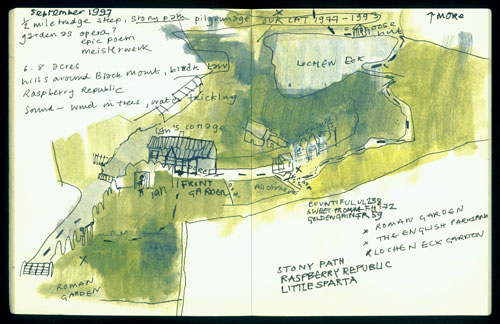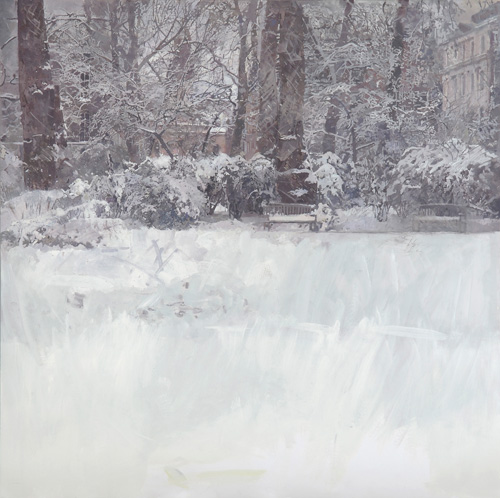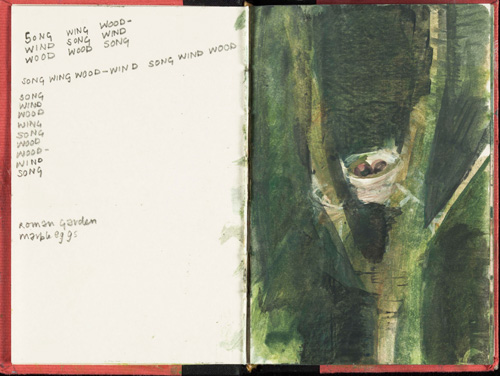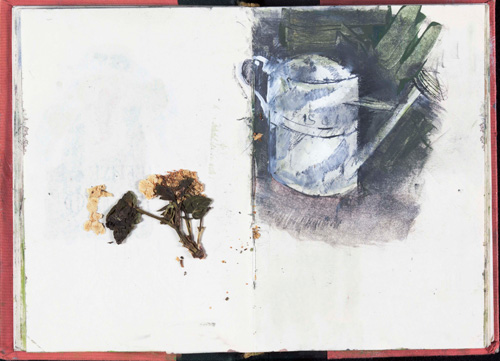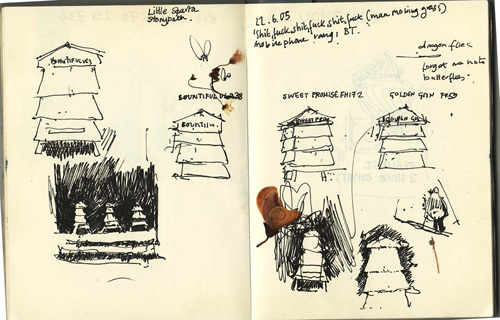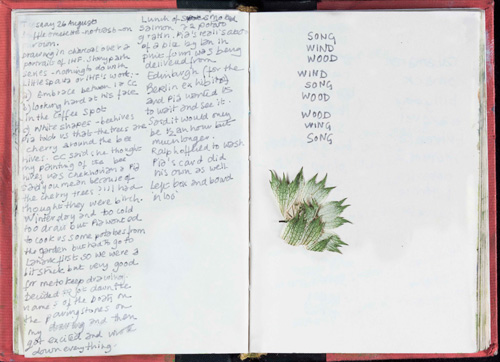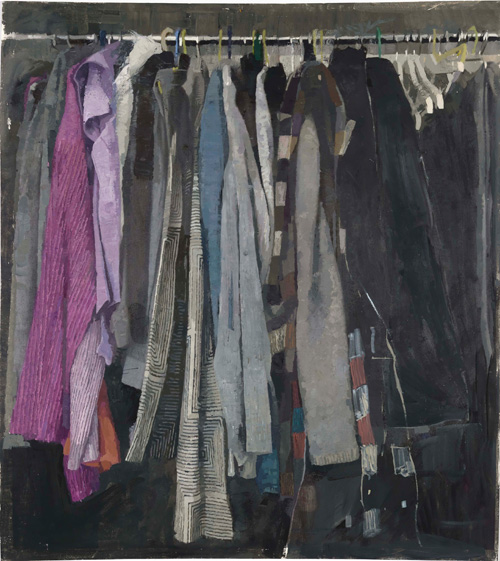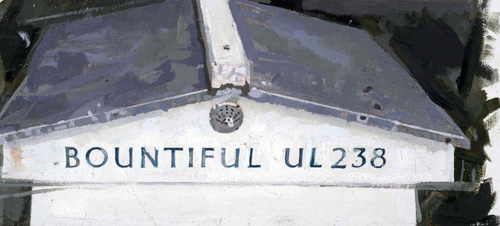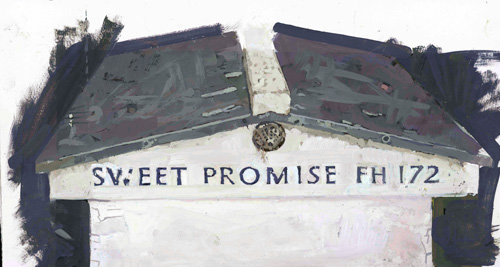

by JANET McKENZIE
The superbly executed paintings of Eileen Hogan (b1946) reveal her commitment to drawing and to the craft of painting. She has had a long association with Little Sparta, the sculpture park and garden in Scotland created by the artist, poet and writer Ian Hamilton Finlay, making hundreds of drawings and paintings of the place, as well as portraits of Hamilton Finlay himself, both during his lifetime and after his death. Little Sparta is punctuated by inscriptions (concrete poetry), columns, obelisks, temples and sundials that conjure the world of classical garden design, 20th-century landscape architecture and conceptual art with a rich tapestry of references to philosophy, classical design, art history and quotidian life today. Little Sparta has been described as the most important garden to be made by a poet since the garden at Twickenham created by Alexander Pope (1688-1744).
Janet McKenzie: Portraiture and drawing were very much out of fashion when you trained, and for decades you have pursued an independent artistic path. Where did you study and who were your most influential teachers?
Eileen Hogan: I studied at Camberwell College of Arts, the Royal Academy Schools, the British School at Athens and the Royal College of Art.
At Camberwell I studied under the first generation of artists who had been influenced by the Euston Road School. I started attending Saturday morning classes when I was 14 and I became a user of the “dot and carry” system of drawing (without knowing anything about William Coldstream as an artist, or being aware of the art school revolution that had taken place). I reacted against this drawing system later, but remained a figurative painter, confronting the question of what my work had to do with the business of being an artist in the 20th and 21st centuries, although, now, being a figurative painter is not so problematic as it has been in previous decades.
At one Saturday class, I had a eureka moment about drawing and I remember clearly walking out on to the Peckham Road, knowing that the way I saw the world had changed. The revelation was being taught to work from the inside of the form of the model and to forget about the edge or outline and to let the figure emerge from the inside without edges. Shortly afterwards, I enrolled on Foundation and then joined the BA painting course at Camberwell. In spite of the fact that Camberwell appeared to be the epitome of what Coldstream had been trying to teach in the Euston Road, I had a plurality of experiences, because Robert Medley was the head of the painting school in my first year. He was very involved with dance and theatre as well as fine art and drew around him a remarkable group of artists to teach at the college, usually for one day a week, including Frank Auerbach, Ron Kitaj, Anthony Fry, Patrick Procktor and Euan Uglow, all exhibiting in London at places like the Lessore Gallery and the Leicester Galleries.
I found Uglow an influential teacher. He set the model in a contorted position for many months and used plumb lines to preserve the model’s very precise pose. He drew chalk marks on the floor so that the model would always return to exactly the same position after breaks. When he drew, as well as fixing the model carefully, he also put a nail in the floor to show him where to place his own foot and this is what we were encouraged to do when we drew. He would draw very slowly and appear to have completed only the edge of the model’s arm after several days. We didn’t draw the model as a person in his class, but as a series of shapes to be measured and compared.
By contrast, when Auerbach taught, or perhaps it would be more accurate to say, was present, we all drew in charcoal and tried to fling it about with the same passion that he did. The studio was filled with a great cloud of black dust. Uglow was more consistently present than Auerbach and I now realise that I experienced the early days of how the life class became polarised between, on the one hand, followers of David Bomberg and Auerbach (charcoal and thick paper) and, on the other, Coldstream and Uglow (measuring and sharp HB pencils). I chose the latter route, although I was later to moderate this.
I witnessed how people worked and what it meant to be an artist. What I found very powerful was learning to observe in an extremely thorough and rigorous way. The artists that Medley brought in to the college provided a gold standard of artistic seriousness.
JMcK: Greece and London parks, explored through travel and walking, are pivotal in your oeuvre, as subject matter and process. Can you explain how drawing enables you to examine a subject and explore an idea?
EH: I have always drawn for as long as I can remember. Working in sketchbooks provided a way out from the Euston Road style. I drew in sketchbooks in an unselfconscious, scribbly way, more like doodling than serious drawing. Writing notes, making lists, drawing the same things over and over again; gradually, this allowed me to learn what really mattered to me. I find out what I’m thinking through this sort of drawing and I find out what really matters to me through working from memory. It’s drawing without trying too hard.
JMcK: Your new exhibition, Edges and Enclosures at Browse and Darby, at first glance might seem a little anachronistic in contemporary art practice, yet it is also eloquent and intriguing. You employ the brushstrokes and love of light of Claude Monet – indeed, your work glows with a rare ability to capture fleeting moments – but you invest mundane objects with conceptual and minimal qualities. Can you explain the manner in which you came to paint beehives at Little Sparta, for example?
EH: Once I’ve found the place where I want to work, I always return to the same spot. Sitting there for long periods is essential, not necessarily because of what I produce – at this point, I’m usually drawing or taking photographs – but because staring and observing becomes a sort of ritual. Memory is important; even directly working from nature involves memory, memories of seeing the gardens in other lights and in other seasons, memories of Ian Hamilton Finlay in the garden that he created and of other people.
I was drawn to the beehives because of the particular sort of space they exist in, set in a line, at the crest of a gently sloping lawn in front of cherry trees. There is remorselessness in the geometry created between the relationships of the cherry trees to the beehives, which is somewhat dissolved in the implicit content of the mood.
JMcK: Beehives recur in your work. Can you explain what you are pursuing in formal terms and also the manner it has become a vessel of meaning?
EH: There are dappled shadows on the dazzling whiteness of the beehives, the light flickers and it sometimes seems like camouflage. It’s a piebald effect and it excites me – the way the shadows show you things and hide things – tension beneath calm.
Beehives in a cherry orchard might be considered rather a banal subject, but I believe that it is possible to demonstrate a profound concern for the evocation of feelings through a sometimes obvious subject matter, an unobtrusive composition, and a desire to invest visual experience with meaning.
JMcK: Can you also explain how Little Sparta impacted on you initially and how your drawing and painting has evolved in response to it?
EH: The aspects of the garden that affected me were the sense of enclosure, the fact that it’s a poet’s garden, that it incorporates words – poems sculpted in wood and stone and sometimes reflected in water. It’s full of echoes of Greek philosophy and classical mythology and, of course, weather and the changing light.
I went there for the first time on 27 September in 1997 to collect Cathy Courtney, the writer and oral historian, who was recording Ian for National Life Stories at the British Library. The recording was part of the project Artists’ Lives, which was established in 1990, a collection of life stories where the practice of making art – and of looking at it and thinking about it – is discussed and documented within as wide a context as possible, not separated from everyday life. This was Ian and Cathy’s second session and they were talking in the tiny ramshackle conservatory at the front of Ian’s cottage with the rain hammering on the glass roof. I drew them both, from the outside looking in, and then spent several hours walking around the garden in sleeting rain and wind.
After Cathy and Ian finished recording, we all walked together in the most brilliant sunshine. Little Sparta seems to exist in its own weather zone, which can be very different from a few miles away and often changes dramatically within the space of one day.
Since 1997, I have returned many times and drawn and painted there a lot, including after Ian’s death in 2006. It’s always a different experience and, as well as everything visual, the sound is remarkable – the sound of the wind constantly blowing in the trees, the sound of the birdsong, the rustle of the breeze in the grasses. Little Sparta is often described as an oasis, the trees create an island, where the sound of the wind and the leaves animate the garden so it becomes like an inland sea. So much of the poetry is about water, boats and sea battles; and nostalgia for the days of the Scottish fishing fleet.
Little Sparta is divided into different sections – gardens within gardens, and there were three places where I eventually worked: the Roman Garden, where I painted Ian, the English Parkland where I painted the beehives, and Lochan Eck Garden, where I painted the Goose Hut.
The fact that Little Sparta was so far from my studio in London clarified my working methods. I like working both on the spot and in the studio, where I surround myself with all the drawings and paintings made in situ. When I am working on a series of paintings the memory of the place is as important as the place itself. I can relate to the story about [Jean-Baptiste-Camille] Corot having a still life set up in one room and working from the memory of it in another.
JMcK: How would you explain your dialogue with Hamilton Finlay through Little Sparta, for it might be considered to be a type of artistic collaboration, as opposed to an artist’s more conventional dialogue with manmade or natural landscape?
EH: In important ways, my work has very little in common with Ian’s. I am a great admirer of his work and my reaction to him and his environment was, and is, part of my emotional response to Little Sparta. I feel that it is a conversation with Ian, not a collaboration. Mel Gooding, in his essay Eileen Hogan: Moments of Vision, wrote: “Hogan’s paintings of Stonypath reflect in their turn a quietly contemplative imagination responding with an acutely transformative sensibility to Ian Hamilton Finlay’s artful horticulture. It is the work of one artist listening with creative attention and inwardness to the creative utterance of another”.
Stonypath is the original name of the garden. It was changed in 1983 to Little Sparta because of a battle with the local council. Strathclyde regional council claimed that, because Ian was using a barn as an art gallery, he would be liable to pay a higher rate of tax. Ian refused, claiming that it was a temple. When the sheriff officer and bailiffs arrived, Ian fought them off. He renamed Stonypath Little Sparta because he did not get the support from the art establishment in Edinburgh that he felt should have – Sparta being the enemy of Athens and Edinburgh the Athens of the north.
JMcK: Little Sparta has been described as having “an embattled, defensive mood, as if paradise was always under threat in the experience of humanity”1, and it has also been said that it defines a form of contemporary sublime. Do you perceive a warning to human beings from Hamilton Finlay through his art and poetry?
EH: I would describe Ian’s work at Little Sparta as a series of philosophical meditations often cloaked in humour but with a deeply serious intent.
JMcK: What do the names and numbers (Bountiful UL 238, Sweet Promise FH 172, Golden Gain FR 59) on the beehives signify?
EH: The beehives are an example of the way Ian’s work often links the land and the sea. They are standard beehives, but each one has painted on it a name of fishing boat and its port registration. Sweet Promise FH 172 fished from Falmouth, Golden Gain FR59 from Fraserburgh and Bountiful UL 238 from Ullapool. The names resonate with the labour of bees and the making of honey and relate to the harvest of the sea.
JMcK: Your choice of subject matter can be seen to invest great value in small, sometimes mundane acts: walking, conversation, dressing. Beehives connote communal work, the care of the environment and your portraits capture subtle ephemeral moment of an individual’s persona. Which artists from the past have most influenced you? Which contemporary artists have been important to your work?
EH: In terms of importance to my work, the English painter Michael Andrews has always been significant. I like the astringency of his work and I found him an inspiration during a long period when being a painter and figurative were both deeply unfashionable.
The practice of mark-making fascinates me. For instance, Edouard Vuillard, who turns his vision of people and where they live into densely patterned painterly surfaces, and Velázquez, whose squiggly marks are illegible close to but from a distance capture light, texture and form perfectly.
I have been always interested in the relationship between words, images and lettering as a form of drawing. When I was a student, I was drawn to the work of the artist and writer David Jones. More recently, of course, to all the text at Little Sparta, but also the work of Cy Twombly – his highly personal “handwriting” and literary content. I like the restrained quality of Brice Marden’s episodic work (working in series is important to me) and in particular his pale-coloured paintings of linear networks.
In terms of impact, last week I came out of the Ai Weiwei exhibition [at the Royal Academy] absolutely reeling. I found the power and bravery of the work, the thrilling distillation and economy of thought mesmeric.
JMcK: Can you explain how your series of works: Self-Portrait Through Wardrobe (2015) came about?
EH: A familiar feature of my indoor life is the wardrobe at the end of my bed, the closely hung stripes of colour formed by a succession of shirts and scarves. The clothes hold something of my shape, memories of when and where they were bought and of times worn. The paintings are a self-portrait that explores how much presence can be achieved in absence and how much an image of a person can be implied through association.
Reference
1. The Garden at Portrack Designed and Created by Charles Jencks (1986-2004): Entrapment and Release by Michael Spens. In: Contemporary Garden Aesthetics, Creations and Interpretations, edited by Michel Conan, published by
Dumbarton Oaks Research Library and Collection and Spacemaker, 2007.
• Eileen Hogan: Edges and Enclosures, Browse and Darby, London, 9 September – 2 October 2015.


